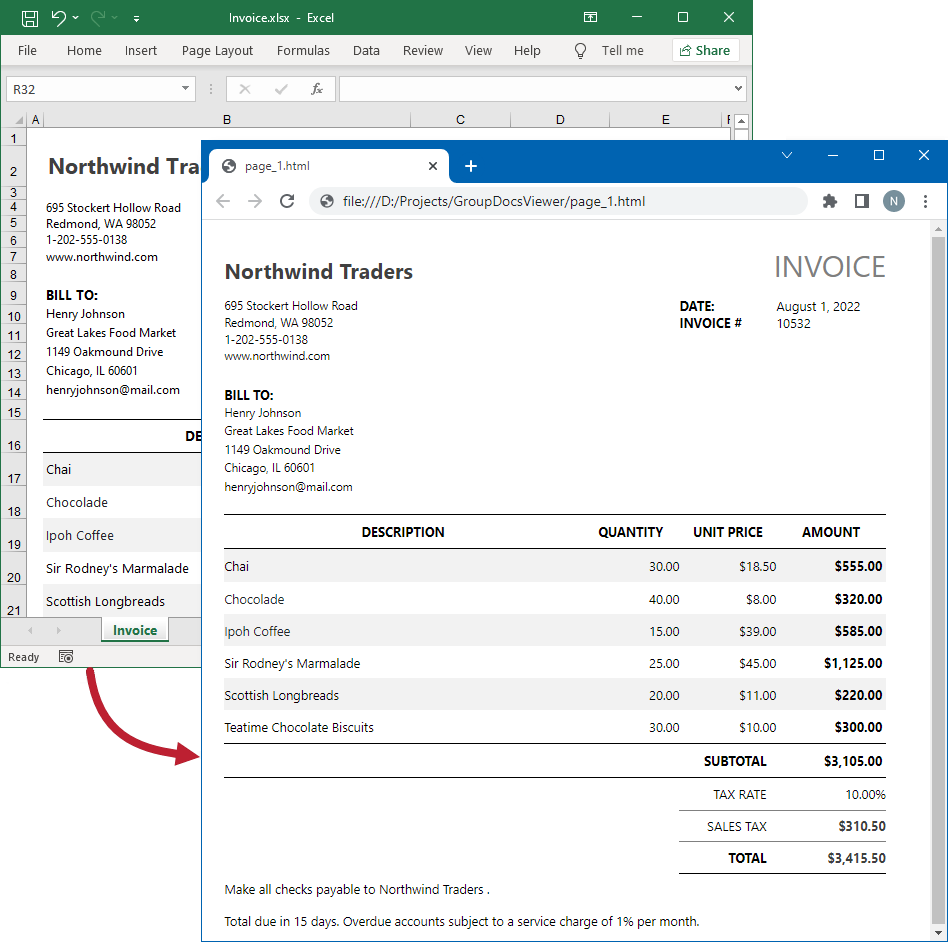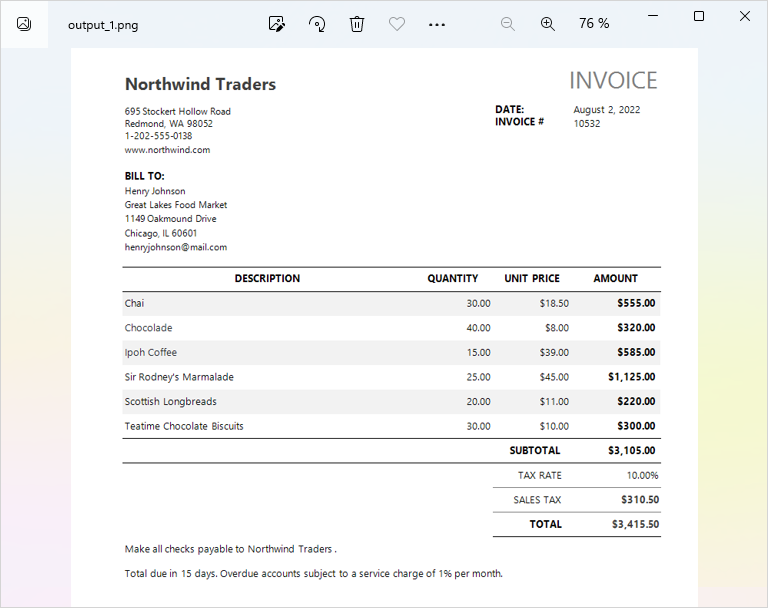View XLSX files
View XLSX files in C#
GroupDocs.Viewer for .NET (which is a part of Conholdate.Total for .NET) allows you to render your spreadsheet files in HTML, PDF, PNG, and JPEG formats. You do not need to use Microsoft Excel or other spreadsheet programs to load and view Excel documents within your .NET application (web or desktop).
To start with the GroupDocs.Viewer API, create a Viewer class instance. Pass a spreadsheet file you want to view to the class constructor. You can load the document from a file or stream. Call one of the Viewer.View method overloads to convert the document to HTML, PDF, or image format. These methods allow you to render the entire document or specific pages.
GroupDocs.Viewer can detect the document format automatically based on information in the file header.
Render spreadsheets as HTML
Create an HtmlViewOptions class instance and pass it to the Viewer.View method to convert a spreadsheet file to HTML. The HtmlViewOptions class properties allow you to control the conversion process. For instance, you can embed all external resources in the generated HTML file, minify the output file, and optimize it for printing.
Create an HTML file with embedded resources
To save all elements of an HTML page (including text, graphics, and stylesheets) into a single file, call the HtmlViewOptions.ForEmbeddedResources method and specify the output file name.
Example 1: Convert an Excel workbook to HTML
using GroupDocs.Viewer;
using GroupDocs.Viewer.Options;
// ...
using (var viewer = new Viewer("invoice.xlsx"))
{
// Convert the spreadsheet to HTML.
// {0} is replaced with the current page number in the file names.
var viewOptions = HtmlViewOptions.ForEmbeddedResources("page_{0}.html");
viewer.View(viewOptions);
}
The following image demonstrates the result:

Create an HTML file with external resources
If you want to store an HTML file and additional resource files (such as fonts, images, and stylesheets) separately, call the HtmlViewOptions.ForExternalResources method and pass the following parameters:
- The output file path format
- The path format for the folder with external resources
- The resource URL format
Example 1: Convert an Excel workbook to HTML
using GroupDocs.Viewer;
using GroupDocs.Viewer.Options;
// ...
using (var viewer = new Viewer("invoice.xlsx"))
{
// Convert the spreadsheet to HTML.
// Specify the HTML file names and location of external resources.
// {0} and {1} are replaced with the current page number and resource name, respectively.
var viewOptions = HtmlViewOptions.ForExternalResources(
"page_{0}.html", "page_{0}/resource_{0}_{1}", "page_{0}/resource_{0}_{1}");
viewer.View(viewOptions);
}
Render spreadsheets as PDF
Create a PdfViewOptions class instance and pass it to the Viewer.View method to convert a spreadsheet file to PDF. The PdfViewOptions class properties allow you to control the conversion process. For instance, you can protect the output PDF file, reorder its pages, and specify the quality of document images. Example 1: Convert an Excel workbook to PDF
using GroupDocs.Viewer;
using GroupDocs.Viewer.Options;
// ...
using (var viewer = new Viewer("invoice.xlsx"))
{
// Convert the spreadsheet to PDF.
var viewOptions = new PdfViewOptions("output.pdf");
viewer.View(viewOptions);
}
The following image demonstrates the result:

Render spreadsheets as PNG
Create a PngViewOptions class instance and pass it to the Viewer.View method to convert a spreadsheet file to PNG. Use the PngViewOptions.Height and PngViewOptions.Width properties to specify the output image size in pixels.
Example 1: Convert an Excel workbook to PNG
using GroupDocs.Viewer;
using GroupDocs.Viewer.Options;
// ...
using (var viewer = new Viewer("invoice.xlsx"))
{
// Convert the spreadsheet to PNG.
// {0} is replaced with the current page number in the file names.
var viewOptions = new PngViewOptions("output_{0}.png");
viewOptions.Width = 800;
viewOptions.Height = 900;
viewer.View(viewOptions);
}
The following image demonstrates the result:

Render spreadsheets as JPEG
Create a JpgViewOptions class instance and pass it to the Viewer.View method to convert a spreadsheet file to JPEG. Use the JpgViewOptions.Height and JpgViewOptions.Width properties to specify the output image size in pixels.
Example 1: Convert an Excel workbook to JPEG
using GroupDocs.Viewer;
using GroupDocs.Viewer.Options;
// ...
using (var viewer = new Viewer("invoice.xlsx"))
{
// Convert the spreadsheet to JPEG.
// {0} is replaced with the current page number in the file names.
var viewOptions = new JpgViewOptions("output_{0}.jpg");
viewOptions.Width = 800;
viewOptions.Height = 900;
viewer.View(viewOptions);
}
Detect a CSV/TSV separator
If you load a CSV/TSV file to convert it to another format, enable the SpreadsheetOptions.DetectSeparator property for a target view to automatically detect a delimiter used to separate values in the source file.
GroupDocs.Viewer can detect the following separators:
- A comma (the default separator)
- A semicolon
using GroupDocs.Viewer;
using GroupDocs.Viewer.Options;
// ...
using (var viewer = new Viewer(@"sample.csv"))
{
var viewOptions = HtmlViewOptions.ForEmbeddedResources();
viewOptions.SpreadsheetOptions.DetectSeparator = true;
viewer.View(viewOptions);
}
Obtain worksheet names
GroupDocs.Viewer allows you to obtain information about the source spreadsheet file. For example, you can retrieve worksheet names, as described below:
- Create a ViewInfoOptions instance for a specific view.
- Call the Viewer.GetViewInfo method and pass the ViewInfoOptions instance to this method as a parameter.
- Use the Pages property of the returned ViewInfo object to iterate through the list of worksheets and retrieve the worksheet names.
using GroupDocs.Viewer;
using GroupDocs.Viewer.Options;
using GroupDocs.Viewer.Results;
// ...
using (var viewer = new Viewer("sample.xlsx"))
{
var viewInfoOptions = ViewInfoOptions.ForHtmlView();
// Call this method to create a single page for each worksheet.
viewInfoOptions.SpreadsheetOptions = SpreadsheetOptions.ForOnePagePerSheet();
var viewInfo = viewer.GetViewInfo(viewInfoOptions);
// Print the worksheet names in the console window.
Console.WriteLine("The document contains the following worksheets:");
foreach (Page page in viewInfo.Pages)
{
Console.WriteLine($" - Worksheet {page.Number}: '{page.Name}'");
}
}
The following image demonstrates a sample console output:
